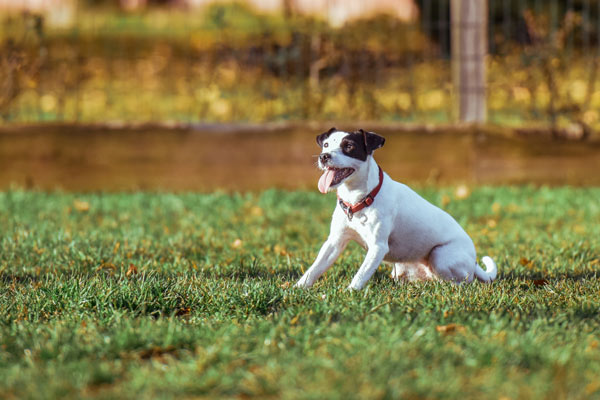Teaching the “Sit”
Focus the dog’s attention on the treat. Begin with the treat held down at your side. Raise that hand in front of the dog’s nose to let him get the scent, then to above his head level.
- When you hold the treat above the dog’s head, most dogs will naturally sit to get a better view of it.
Give him an immediate treat and praise. Follow the routine of clicker-treat/praise or just treat and praise. Say “good sit” when he’s performing the behavior you are practicing. He may be slow at first, but more treats and praise will speed up his response.
- Make sure that you do not praise him until his butt touches the ground. If you praise halfway through the sit, the dog will think that is what you want.
- Also, make sure that you do not praise him for getting back up, or you will get that behavior instead of the sit.
If your dog does not sit with the treat technique, you can use your leash and collar. Stand next to the dog, facing the same direction as him. Place a little backward pressure on the collar to encourage a sit.
- You may even need to encourage the sit by adding a little gentle scoop behind the dog’s hind legs. Gently lean the dog backward with the help of the collar while doing this.
- As soon as he sits, give him immediate praise and reward.
Don’t repeat the command. You want the dog to respond on the first utterance, not the second, third, or fourth. If the dog does not perform the behavior within 2 seconds of your command, reinforce the command with the help of your leash.
- When you begin training a dog, never give a command that you are not in a position to reinforce. Otherwise, you risk training the dog to ignore you because there is no follow through from your end and the commands have no meaning.
- Create a positive meaning for the dog with praise and consistency.[7]
Praise natural sitting behavior. Look for times throughout the day when your dog just sits on his own. Praise that behavior, and pretty soon you’ll have a dog that sits for attention instead of jumping or barking at you.
Teaching Your Dog to Lie Down
Get your dog’s attention. Get some food treats or a toy and find your dog. Hold the toy or treat in view so he focuses on you.
Use the treat or toy to encourage your dog to lie down. Do this by moving the toy or treat onto the ground in front of the dog, between his front legs. His head should follow it, and his body should follow shortly thereafter.
Give immediate praise. When the dog’s stomach is on the ground, lavish him with praise and give him the treat or toy. Be accurate with your praise, too. If you praise him halfway down or up, that is the behavior you will get.
Increase your distance. Once he’s learned the behavior with the promise of a treat below him, move a little farther away. The hand signal for “down” will become your flat hand — palm down — moving in a downward direction from in front of your waist to your side.
- As the dog gets more consistent with the “down” behavior, add a verbal “down” or “lie down” command.
- Always praise him immediately when his belly is on the ground.
- Dogs read body language well and learn hand signals quite quickly.
Lengthen the “down.” As he gets more reliable with “down,” pause a few seconds before praising and treating to encourage him to hold the position.
- If he pops up to get the treat, do not give it to him, or you will be rewarding the last behavior he did before the treat.
- Just start again, and the dog will understand that you want him all the way down on the ground, as long as you are consistent.
Don’t lean over your dog. Once your dog has caught onto the command, stand up straight when giving it. If you loom over him, you’ll have a dog that only lays down when you are leaning over him. You want to work on being able to get your dog to lie down from across the room, eventually.
Training Your Dog to “Wait” at Doorways
Begin doorway “wait”-training early. Teaching a dog to respect the threshold is important. You do not want a dog that runs out the door every time it opens — that could be dangerous for him. Doorway training doesn’t need to happen every single time you go through a doorway. But you should make the most of your training opportunities early in your puppy’s life.
Place the dog on a leash. You should have him on a short leash that allows you to change his direction from a close distance.
Walk to the door. Bring the dog along with you on his leash.
Give a “wait” command before stepping through. If your dog moves to follow you when you step through the door, use the leash to stop his forward movement. Try again.
Praise him when he waits. When he realizes that you want him to stay in the door instead of walking through it with you, lavish him with praise and rewards for the “good wait.”
Teach him to sit in the threshold. If the door is closed, you can even teach your dog to sit as soon as you place your hand on the doorknob. He’ll then wait while the door is opened, and not cross the threshold until you release him. This training should be done on leash at the beginning, for his safety.
Give a separate command to encourage him through the doorway. You might use a “come” or a “free.” Whatever command you use, it should be the only thing that allows your dog to exit your home.
Teaching the “Stand”
Understand the value of the “stand” command. The value of the “sit” and “wait” seem obvious, but you may not understand at first why the “stand” is an important skill to teach your dog. You’ll won’t use the “stand” every day, but you’ll need it throughout the dog’s life. For example, a dog who can stay calmly in a “stand” is the ideal patient at a vet clinic or client at a groomer’s.
Focus the dog’s attention. You want to coax him into the standing position by having him follow the toy or treat. Hold the toy or treat in front of his face, at nose height.
- If he sits, thinking that will earn him a reward, try again, but with the treat or toy slightly lower.
Encourage the dog to follow your hand. Flatten your hand with your palm down. If you’re using a treat, hold it with your thumb against your palm. Start with your hand in front of his nose and move it away a few inches. The idea is that the dog will stand up while following your hand.
- You may need to use your other hand to encourage him from underneath his hips to get the idea at first.
Give immediate praise. As soon as he reaches the standing position, praise and treat. Although you haven’t yet started using the verbal “stand” command, you can use it in your praise: “good stand!”
Add the verbal “stand” command. At first, you will work only on getting your dog to stand by following the hand that holds his toy or treat. When he’s mastered that concept, begin incorporating the “stand” command into the training sessions.
Combine the “stand” with other commands. There are many ways to combine commands. After getting your dog to “stand,” you might add a “wait” or “stay” command if you want the dog to stand for longer periods of time. You can also follow with a “sit” or “down” to do some “doggy drills,” and gradually increase the distance between you and the dog. Eventually, you’ll have your dog performing these commands from across the room.
Sources:
- http://www.aspca.org/pet-care/virtual-pet-behaviorist/dog-behavior/training-your-dog
- http://www.caninejournal.com/jack-russell-terrier-personality/
- http://www.pawnation.com/2014/03/13/low-energy-dog-breeds/3
- http://www.aspca.org/pet-care/virtual-pet-behaviorist/dog-behavior/teaching-your-dog-not-pull-leash
- http://www.aspca.org/pet-care/virtual-pet-behaviorist/dog-behavior/teaching-your-dog-come-when-called
- http://www.successdogs.com/dog-training-lessons/collar-grab-game/
- http://www.aspca.org/pet-care/virtual-pet-behaviorist/dog-behavior/training-your-dog
- https://www.cesarsway.com/dog-behavior/food-aggressive/food-aggression-and-what-to-do-about-it
- https://www.cesarsway.com/dog-behavior/food-aggressive/food-aggression-and-what-to-do-about-it
- https://positively.com/dog-behavior/basic-cues/leave-it/
- http://www.humanesociety.org/animals/dogs/tips/how_to_stop_barking.html
- http://www.humanesociety.org/animals/dogs/tips/crate_training.html
- http://www.aspca.org/pet-care/virtual-pet-behaviorist/finding-professional-help

